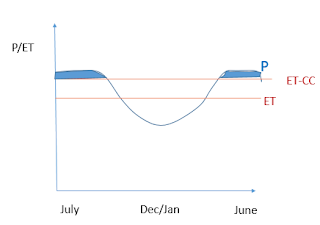I want to start, by referring to
my first blog post, with map number 2 showing the intrinsic variability in
rainfall across the African continent. We can distinguish different patterns of
seasonality, ranging from highly seasonal rainfall in arid environments (e.g. Sudan)
to seasonally humid environments with most months experiencing precipitation (e.g.
Malawi).
Adding to the annual rainfall
variability, it is also important to acknowledge the year-to-year rainfall
variability in Africa, and the rainfall variability within a certain period of
year (especially onset of wet season).
Blue water resources: renewable
freshwater resources, such as river discharge of a permanent river.
I want to extrapolate the occurrence
of “blue water resources” on this rainfall variability by examining the influence
of evapotranspiration at present and under climate change.
Blue water resources are only
possible to be formed when the rainfall exceeds the evapotranspiration – thus,
in all African regions, only certain months of the year contribute to their
maintenance. In the tropical regions and the Sahel, temperatures throughout the
year are relatively warm and stable and therefore potential evapotranspiration
rates do not vary as greatly as in higher latitudes (temperate climates).
Rainfall, however, as I have outlined previously, varies greatly in
its distribution and sums.
Sudan’s mean rainfall throughout
the year never significantly exceeds the constant evapotranspiration (ET) loss threshold
and this explains the lack of blue water in the Sahel. A warming planet, and
the resulting rise in potential evapotranspiration will only increase this
threshold further, and reduce the number of years (and months in a year) rainfall exceeds this.
It is interesting to show the
potential of a rise in this ET threshold on regions with blue water resources,
such as in the seasonally humid tropics of Africa. For simplicity, and due to
the uncertainty of GCM model output in predicting future rainfall, the precipitation
pattern is left unchanged. In the diagrams below, the shaded blue area
represents potential renewable freshwater resources at present (ET) and under
rising temperatures (ET-CC).


